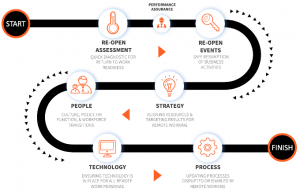
Employees may encounter new temperature screening and symptom checks, changes to office layout, or policies against gathering around the water cooler. But in most cases, the thrust of the effort is to get “back to normal”—that is, back to the office.
However, collecting large numbers of people in indoor workplaces, especially as a second wave of the pandemic looms and expert advice evolves, increases risks to public health and the health of the organization’s employees. Employees may also not yet be ready for the office, whether due to fear of exposure or unresolved disruptions to their home lives that prevent return.
If you’re creating or refining a reopening plan, consider this: for many businesses and many employees, there are huge benefits to developing a permanently flexible working environment. Instead of moving back to office-based models for familiarity reasons alone, businesses can embrace the large-scale remote working context they have found themselves in, and make a permanent, holistic shift to address the attendant challenges.
There are certainly stresses involved in working remotely—many workers are juggling dependent care responsibilities, space restrictions, lack of privacy, and psychological and emotional impacts of the pandemic we don’t yet fully understand. But companies that acknowledge these difficulties and develop support structures to mitigate or counteract them will find that in many cases they come out ahead financially, while also boosting employee productivity and morale.
There isn’t an easy one-size fits all solution that will work for all companies. From our conversations with mid-to-large size customers across various industries, below is the approach that we believe companies should follow to calculate the balance of onsite and remote working that’s right for them in the long run.
Assess the Potential for Sustained Remote Working in Your Business
In the last few months, Google, Microsoft, and Facebook have declared that all employees will be working for home until 2021. A few companies have gone even further. Twitter and Square announced that they see no reason why the employees can’t continue to work for home “forever.” But while the technology industry at large may be quick to adapt a work–from–home model, not all industries are as well suited to do so. And regardless of industry, certain occupations and jobs just can’t be performed from home. The Becker Friedman Institute for Economics at the University of Chicago recently published a study on the degree to which different industries and occupations may be able to embrace remote work.
 In order to understand their specific potential for sustained remote work, we’re encouraging companies to evaluate how remote-effective they can be by department, function, and ultimately on a job-by-job basis. There are several factors to consider for each job, including the degree of autonomy, scheduling flexibility, and the inherent use of technology to perform work functions. Upon completing this evaluation, organizations will be able to categorize each job based on its potential for transition to a partial or even fully remote working model. Trans4mative Advisors has built a tool and framework to help with this analysis and forecast the financial impact of a transition to a hybrid onsite/offsite working model, factoring in changes to employee productivity, absenteeism, and turnover as well as improved business continuity and real estate savings.
In order to understand their specific potential for sustained remote work, we’re encouraging companies to evaluate how remote-effective they can be by department, function, and ultimately on a job-by-job basis. There are several factors to consider for each job, including the degree of autonomy, scheduling flexibility, and the inherent use of technology to perform work functions. Upon completing this evaluation, organizations will be able to categorize each job based on its potential for transition to a partial or even fully remote working model. Trans4mative Advisors has built a tool and framework to help with this analysis and forecast the financial impact of a transition to a hybrid onsite/offsite working model, factoring in changes to employee productivity, absenteeism, and turnover as well as improved business continuity and real estate savings.
Build a Holistic Plan to Support Remote Working
Once the potential for sustained remote working is understood, organizations need to develop a holistic plan that addresses their culture, employee support systems, business processes, and technologies to enable a smooth transition to the new way of working.

First of all, companies need to be prepared to address any underlying trust issues and biases against remote working in their organization. One of my colleagues recently wrote about overcoming his own biases against working from home, and it’s likely that despite the best intentions, many executives and managers struggle to trust remote workers. It’s hard to control what you can’t see, after all. Businesses that want to increase their remote workforce need to provide tools and training to help managers adapt to leading remote teams.
From an employee perspective, not everyone will be able to adapt seamlessly to working outside of the office. Remote workers often feel isolated and disconnected, especially if their employer adopts a hybrid model where some employees work onsite and others work from home. Employers must commit to supporting partial or fully remote employees from a professional standpoint by providing training, clear policies, and fair and aligned recognition and rewards systems. In addition, they should invest in support systems and resources to address their employees’ anxieties and personal challenges.
In addition, approximately a third of the national workforce is made up of parents. For this group, working remotely during the pandemic thus far has been a continuous negotiation of schedules, a delicate balancing act of conference calls and nap times, and against all odds finding a way to care and feed for children while meeting work deadlines. Until schools and child care centers reopen, this segment of the working population is uniquely challenged. Employers should acknowledge and address these difficulties head-on, in individual conversations with each employee if need be—the transition to remote work means employers will need to know and connect with their employees even more, not less.
Finally, businesses need to understand which of their core business processes will be disrupted or significantly affected by a shift to remote work. A good place to start is by closely reviewing the last few months and identifying the processes that were most strained during the recent forced period of unplanned remote working. In order to make these processes more conducive to a strategic workplace shift, companies should find and eliminate unnecessary tight coupling of steps in workflows, and look for ways to modify functions and tasks so they can be performed independently and asynchronously. Digital work assignment and management technologies can help with this transition. Fundamentally, a remote workforce will require an enterprise technology architecture that enables digital work processes, collaboration, and communication through secure channels. Most organizations will find that they’ll need to expand their technology landscape to support the needs of partial or fully remote workers at scale.
For most companies, transitioning to a remote working model isn’t going to be as simple as ripping off a Band-Aid. And there isn’t a standard operating model for businesses to adopt as they position themselves for a greater degree of remote working. But with skillful planning and execution, a strategic rethinking of the workplace can address the ethical and safety concerns posed by reopening while also yielding long-term, transformational benefits for employers and employees alike.
Access all of Trans4mative’s resources for adapting your workplace for increased remote working here.
AASHISH PAREKH
Partner @ Trans4mative Advisors
aashish.parekh@trans4mative.com